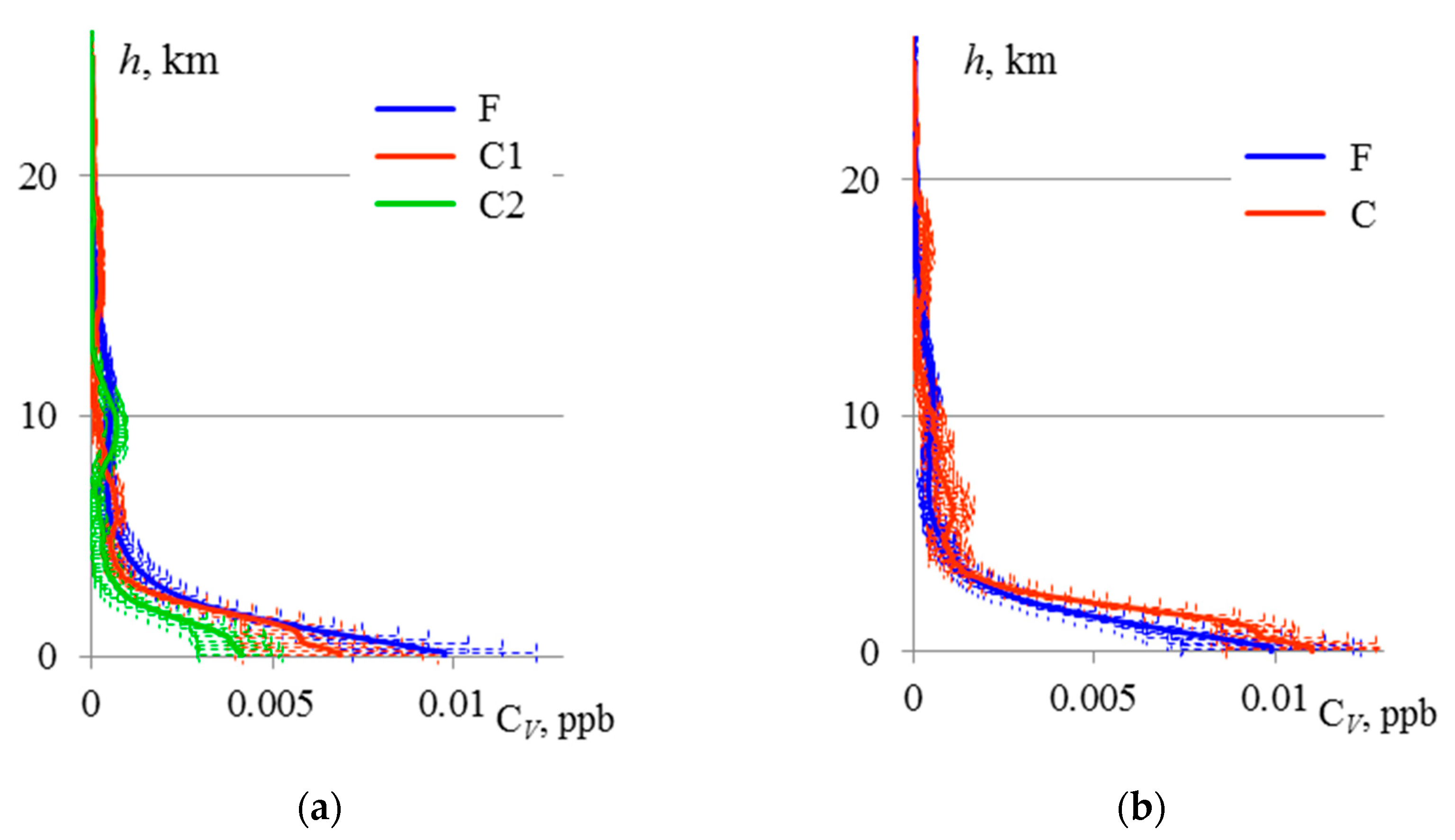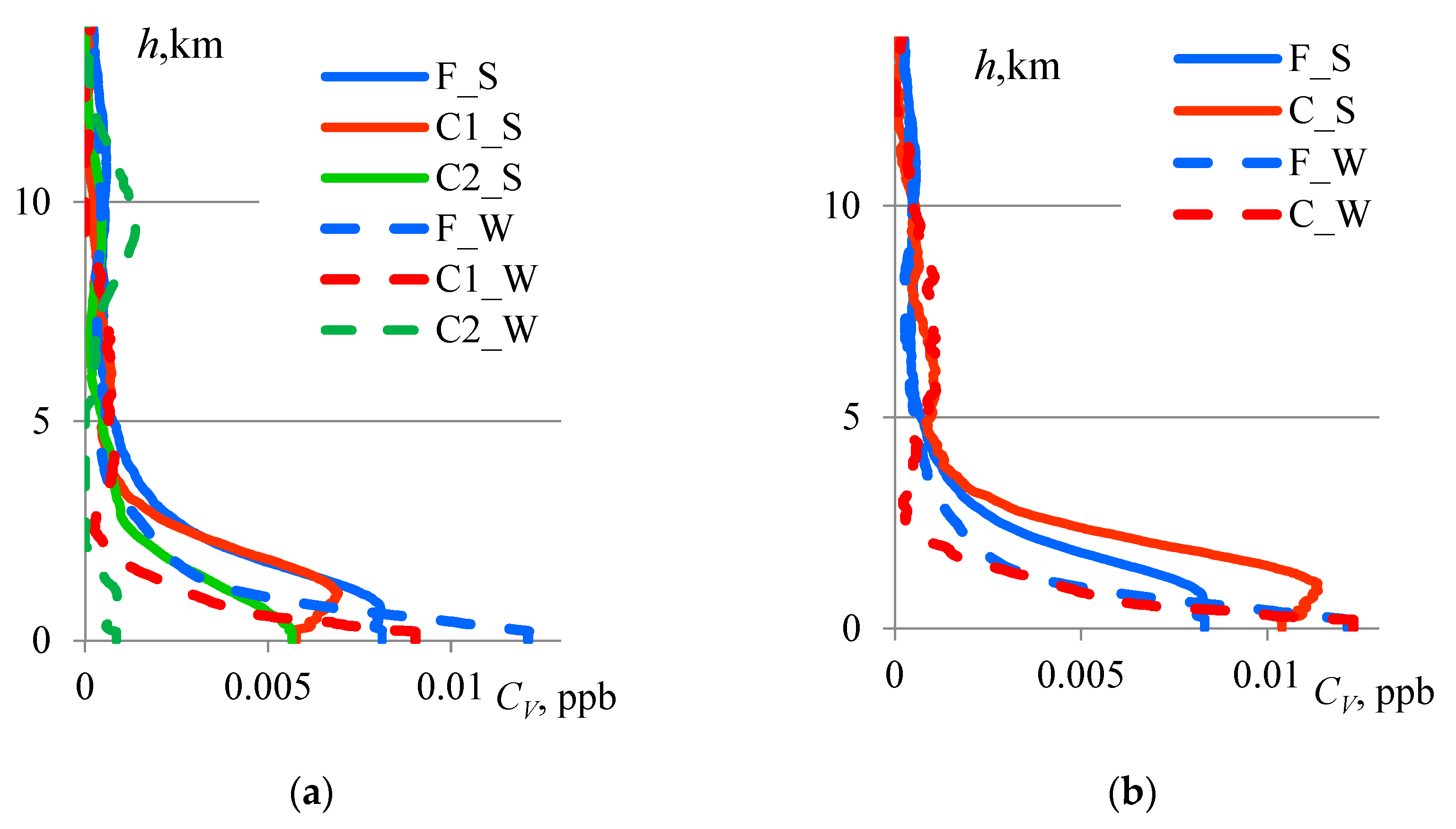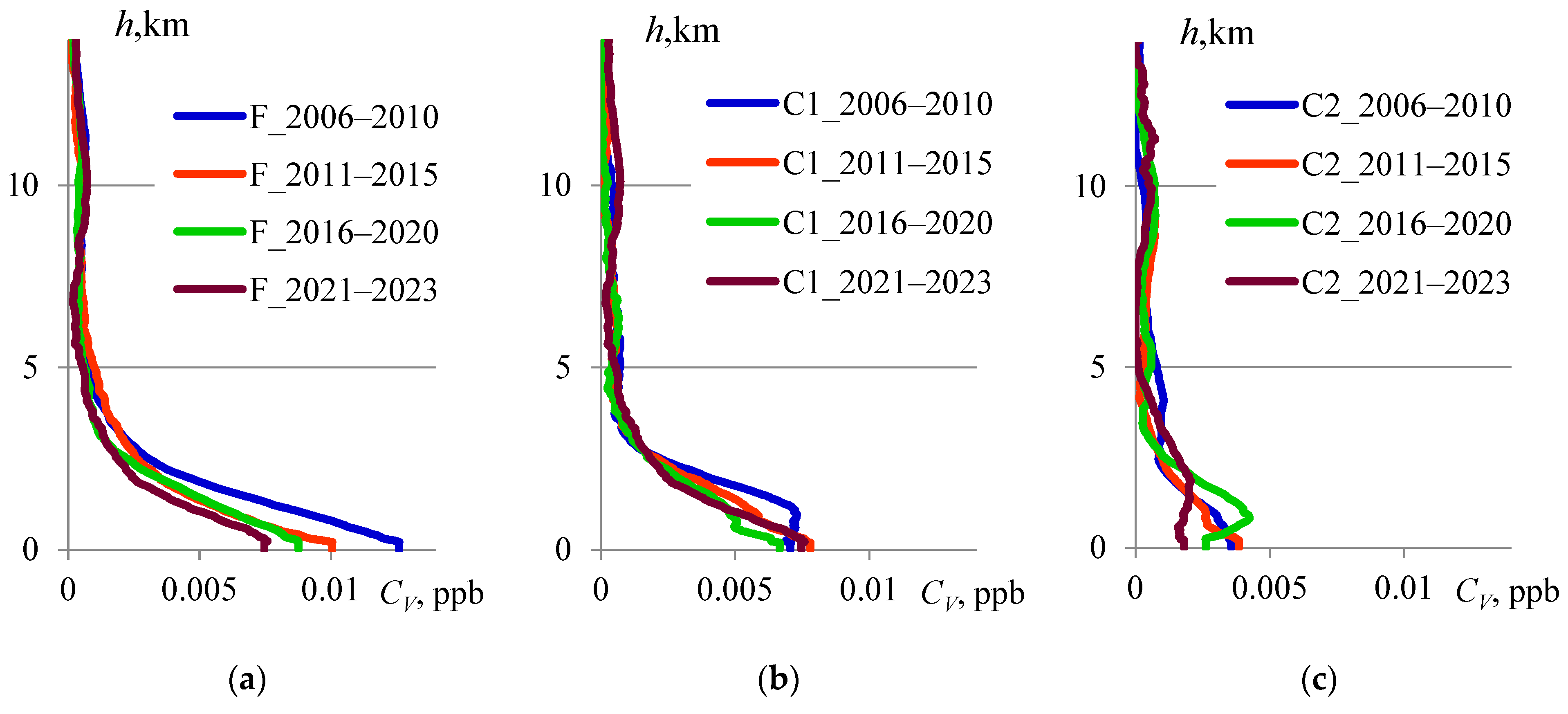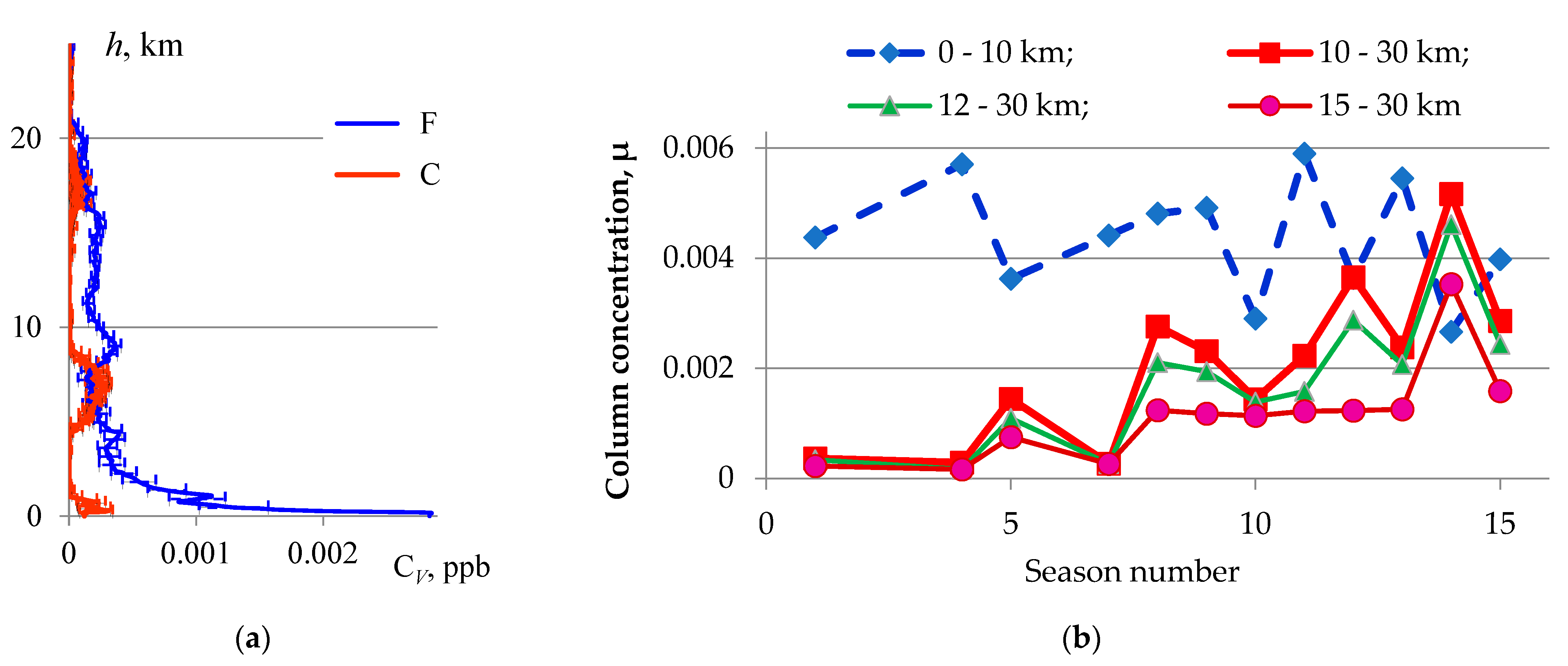Synergy of CALIOP and Ground-Based Solar Radiometer Data to Study Statistical Characteristics of Aerosols in Regions with a Low Aerosol Load †
Abstract
1. Introduction
2. Method and Processing Procedure
2.1. Idea of the Method
- −
- adding statistical characteristics of aerosol particles to the aerosol optical model;
- −
- defining the equations of relation between the statistical characteristics of input datasets and the parameters of the aerosol optical model;
- −
- correcting the algorithms for the final stage of LRS-C data processing, i.e., determination of the target parameters of the aerosol model, which minimize the differences between the measured and calculated statistical characteristics of the input datasets.
2.2. Statistical Ensemble of Input Data
3. Results
3.1. Temporal Aerosol Changes
- −
- the AERONET two-mode aerosol model with fine (F) and coarse (C) aerosol modes; the ensemble of input data includes arrays of lidar signals at 532 and 1064 nm and column optical parameters of aerosol modes calculated from radiometric observations;
- −
- the more detailed three-mode aerosol model in which the coarse mode is divided into two submodes of coarse spherical (C1) and coarse non-spherical (C2) particles; the ensemble of input data is supplemented with rows of the depolarized lidar signals at 532 nm and column values of the “sphericity” (ratio of the column concentration of C1 particles to the column concentration of total coarse particles).
3.2. Aerosol Concentration Profiles in the East Antarctic Region
4. Discussion and Conclusions
Author Contributions
Funding
Institutional Review Board Statement
Informed Consent Statement
Data Availability Statement
Acknowledgments
Conflicts of Interest
References
- The Cloud-Aerosol Lidar and Infrared Pathfinder Satellite Observation (CALIPSO). Available online: https://www-calipso.larc.nasa.gov/ (accessed on 31 October 2023).
- Chaikovsky, A.; Chaikovskaya, L.; Denishchik-Nelubina, N.; Fedarenka, A.; Oshchepkov, S. Lidar&radiometer inversion code (LIRIC) for synergetic processing of EARLINET, AERONET and CALIPSO lidar data. EDJ Web Conf. 2018, 176, 1–4. [Google Scholar] [CrossRef][Green Version]
- Chaikovsky, A.; Bril, A.; Fedarenka, A.; Goloub, P.; Hu, Q.; Lopatin, A.; Lapyonok, T.; Miatselskaya, N.; Torres, D.; Fuertes, D.; et al. Synergetic Observations by Ground-Based and Space Lidar Systems and Aeronet Sun-Radiometers: A Step to Advanced Regional Monitoring of Large Scale Aerosol Changes. EPJ Web Conf. 2020, 237, 1–4. [Google Scholar] [CrossRef]
- Chaikovsky, A.P.; Bril, A.I.; Fedarenka, A.S.; Peshcharankou, V.A.; Denisov, S.V.; Dick, V.P.; Asipenka, F.P.; Miatselskaya, N.S.; Balin, Y.S.; Kokhanenko, G.P.; et al. Synergy of ground-based and satellite optical remote measurements for studying atmospheric aerosols. J. Appl. Spectrosc. 2020, 86, 1092–1099. [Google Scholar] [CrossRef]
- Chaikovsky, A.; Dubovik, O.; Holben, B.; Bril, A.; Goloub, P.; Tanré, D.; Pappalardo, G.; Wandinger, U.; Chaikovskaya, L.; Denisov, S.; et al. Lidar-Radiometer Inversion Code (LIRIC) for the retrieval of vertical aerosol properties from combined lidar/radiometer data: Development and distribution in EARLINET. Atmos. Meas. Tech. 2016, 9, 1181–1205. [Google Scholar] [CrossRef]
- NASA; Goddard Space Flight Center; AERONET; Aerosol Robotic Network. Available online: https://aeronet.gsfc.nasa.gov/ (accessed on 5 September 2023).
- Li, Z.Q.; Xu, H.; Li, K.T.; Li, D.H.; Xie, Y.S.; Li, L.; Zhang, Y.; Gu, X.F.; Zhao, W.; Tian, Q.J. Comprehensive study of optical, physical, chemical and radiative properties of total columnar atmospheric aerosols over China: An overview of Sun-sky radiometer Observation NETwork (SONET) measurements. Bull. Am. Meteorol. Soc. 2018, 99, 739–755. [Google Scholar] [CrossRef]
- Chaikovsky, A.P.; Bril, A.I.; Pescherenkov, V.A.; Meтeльcкaя, N.S.; Malinka, A.V.; Ocипeнкo, F.P.; Korol, M.M.; Goloub, P.; Podvin, T.; Blarel, L.; et al. A statistical approach to the synergy of data from CALIOP and ground-based radiometric stations for studying altitude profiles of aerosol parameters. J. Appl. Spectrosc.. 2024, 49, 367–377. [Google Scholar] [CrossRef]
- Liu, Z.; Vaughan, M.A.; Winker, D.M.; Hostetler, C.H.; Poole, L.R.; Hlavka, D.; Hart, W.; McGill, M. Use of probability distribution functions for discriminating between cloud and aerosol in lidar backscatter data. J. Geophys. Res. 2004, 109, D15202. [Google Scholar] [CrossRef]
- OPeNDAP [Electronic Resource]: Advanced Software for Remote Data Retrieval. Mode of Acc. Available online: https://www.earlinet.org (accessed on 31 October 2023).
- González, R.; Toledano, C.; Román, R.; Mateos, D.; Asmi, E.; Rodríguez, E.; Lau, I.C.; Ferrara, J.; D’Elia, R.; Antuña-Sánchez, J.C.; et al. Characterization of Stratospheric Smoke Particles over the Antarctica by Remote Sensing Instruments. Remote Sens. 2020, 12, 3769. [Google Scholar] [CrossRef]




| Time Period | Fine (F) | Coarse Spherical (C1) | Coarse Spheroid (C2) | AOD (532) |
|---|---|---|---|---|
| 2006–2010 | 0.029 | 0.022 | 0.011 | 0.19/0.15 |
| 2011–2015 | 0.023 | 0.019 | 0.011 | 0.15/0.11 |
| 2016–2020 | 0.021 | 0.018 | 0.012 | 0.14/0.10 |
| 2021–2023 | 0.019 | 0.019 | 0.010 | 0.12/0.08 |
Disclaimer/Publisher’s Note: The statements, opinions and data contained in all publications are solely those of the individual author(s) and contributor(s) and not of MDPI and/or the editor(s). MDPI and/or the editor(s) disclaim responsibility for any injury to people or property resulting from any ideas, methods, instructions or products referred to in the content. |
© 2024 by the authors. Licensee MDPI, Basel, Switzerland. This article is an open access article distributed under the terms and conditions of the Creative Commons Attribution (CC BY) license (https://creativecommons.org/licenses/by/4.0/).
Share and Cite
Chaikovsky, A.; Bril, A.; Goloub, P.; Li, Z.; Peshcherenkov, V.; Asipenka, F.; Blarel, L.; Dubois, G.; Korol, M.; Lapionak, A.; et al. Synergy of CALIOP and Ground-Based Solar Radiometer Data to Study Statistical Characteristics of Aerosols in Regions with a Low Aerosol Load. Environ. Sci. Proc. 2024, 29, 70. https://doi.org/10.3390/ECRS2023-16860
Chaikovsky A, Bril A, Goloub P, Li Z, Peshcherenkov V, Asipenka F, Blarel L, Dubois G, Korol M, Lapionak A, et al. Synergy of CALIOP and Ground-Based Solar Radiometer Data to Study Statistical Characteristics of Aerosols in Regions with a Low Aerosol Load. Environmental Sciences Proceedings. 2024; 29(1):70. https://doi.org/10.3390/ECRS2023-16860
Chicago/Turabian StyleChaikovsky, Anatoli, Andrey Bril, Philippe Goloub, Zhengqiang Li, Vladislav Peshcherenkov, Fiodar Asipenka, Luc Blarel, Gael Dubois, Mikhail Korol, Aliaksandr Lapionak, and et al. 2024. "Synergy of CALIOP and Ground-Based Solar Radiometer Data to Study Statistical Characteristics of Aerosols in Regions with a Low Aerosol Load" Environmental Sciences Proceedings 29, no. 1: 70. https://doi.org/10.3390/ECRS2023-16860
APA StyleChaikovsky, A., Bril, A., Goloub, P., Li, Z., Peshcherenkov, V., Asipenka, F., Blarel, L., Dubois, G., Korol, M., Lapionak, A., Malinka, A., Miatselskaya, N., Podvin, T., & Zhang, Y. (2024). Synergy of CALIOP and Ground-Based Solar Radiometer Data to Study Statistical Characteristics of Aerosols in Regions with a Low Aerosol Load. Environmental Sciences Proceedings, 29(1), 70. https://doi.org/10.3390/ECRS2023-16860









